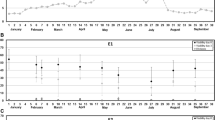Summary
In microspore cultures of Brassica napus L. cv. Topas, embryo yield increases with culture density up to about 40,000 microspores per ml. A much higher density (100,000 per ml) appears inhibitory to embryogenesis. A relatively high culture density (30,000 or 40,000 per ml) for the first 2–4 days of culture is crucial for embryogenesis, after which cultures may be diluted to allow better embryo growth.
Medium conditioned by culturing microspores at 30,000 or 40,000 per ml for 1 day improved microspore-embryo yield in low density cultures (3,000 or 4,000 per ml) more than 3-fold. In contrast, media conditioned with microspores from 1–4 days or 0–4 days of culture were inhibitory.
Use of feeder cultures resulted in up to 10-fold increase of embryo yield in low density microspore cultures, depending on the method used. Filter papers and other membranes placed on top of feeders greatly inhibited embryogenesis in the feeder layer as well as microspores cultured on the feeder, possibly due to poorer gaseous exchange.
Similar content being viewed by others
References
Chuong, PV, Beversdorf, WD (1985) High frequency embryogenesis through isolated microspore culture in Brassica napus L and B. carinata Braun. Plant Science, 39: 219–226
Dunwell, JM (1979) Anther culture in Nicotiana tabacum: The role of the culture vessel atmosphere in pollen embryo induction and growth. J.Expt.Bot. 30: 419–428
Ean, Z, Armstrong, K and Keller, WA (1988) Development of microspores in vitro in Brassica napus L. Protoplasma 147:191–199
Gamborg, OL, Miller, RA and Ojima, L (1968) Requirements of suspension cultures of soybean rootcells. Expt. Cell Research 50: 151–158
Gland, A, Lichter, R and Schweiger, HG (1988) Genetic and exogenous factors affecting embryogenesis in isolated microspore cultures of Brassica napus L.J. Plant. Physiol. 132:613–617
Keller, WA, Arnison, PG and Cardy, BJ (1987) Haploids from gametophytic cells — recent developments and future prospects. In Plant Tissue and Cell culture, Alan R.Liss Inc. 223–241
Kohler, F and Wenzel, G (1985) Regeneration of isolated barley microspores in conditioned medium and trials to characterise the responsible factor. J. Plant. Physiol. 121:181–191
Kott, LS, Polsoni, L and Beversdorf, WD (1988a) Cytological aspects of isolated microspore culture of Brassica napus. Can.J.Bot. 66:1658–1664
Kott, LS, Polsoni, L, Ellis, B and Beversdorf, WD (1988b) Autotoxicity in isolated microspore cultures of Brassica napus. Can.J.Bot. 66:1665–1670
Lawrence, WA and Davies, DR (1985) A method for the microinjection and culture of protoplasts at very low densities. Plant Cell Rep. 4: 33–35
Lichter, R (1981) Anther culture of Brassica napus in a liquid medium. Z. Pflanzenphysiol. 103: 229–237
Neuhaus, G, Spangenberg, G, Scheid, OM and Schweiger, HG (1987) Transgenic rapeseed plants obtained by the microinjection of DNA into microspore-derived embryoids. Theor.Appl.Genet. 75: 30–36
Lichter, R (1982) Induction of haploid plants from isolated pollen of Brassica napus. Z.Pflanzenphysiol. 105:427–434
Pechan, PM and Keller, WA (1988) Identification of potentially embryogenic microspores in Brassica napus. Physiol. Plant. 74: 377–384
Polsoni, L, Kott, LS and Beversdorf, WD (1988) Large scale microspore culture technique for mutation-selection studies in Brassica napus. Can.J.Bot. 66: 1681–1685
Simmonds, DH and Keller, WA (1989) High plating efficiency from low density cultures of suspension culture derived protoplasts of Brassica napus. J. Plant Physiol. Submitted
Somers, DA, Birnerg, WL and Brenner, ML (1987) The effect of conditioned medium on colony formation from “Black Mexican Sweet” corn protoplasts. Plant Science, 53:249–356
Spangenberg, G, Koop, HU, Lichter, R and Schweiger, HG (1986) Microculture of single protoplasts of Brassica napus. Physiol.Plant. 66: 1–8
Swanson, EB, Coumans, MP, WU, SC & Barsby, TL (1987) Efficient isolation of microspores and the production of microspore derived embryos from Brassica napus. Plant Cell Reports 6: 94–97
Toyoda, H, Matsuda, Y, Utsumi, R and Ouchi, S (1988) Intranuclear microinjection for transformation of tomato callus cells. Plant Cell Rep. 7: 293–296
Xu, ZH, Huang, B and Sunderland, N (1981) Culture of barley anthers in conditioned media. J. Expt. Bot. 32: 767–778
Author information
Authors and Affiliations
Additional information
Communicated by A. R. Gould
Rights and permissions
About this article
Cite this article
Huang, B., Bird, S., Kemble, R. et al. Effects of culture density, conditioned medium and feeder cultures on microspore embryogenesis in Brassica napus L. cv. Topas. Plant Cell Reports 8, 594–597 (1990). https://doi.org/10.1007/BF00270061
Received:
Revised:
Issue Date:
DOI: https://doi.org/10.1007/BF00270061




